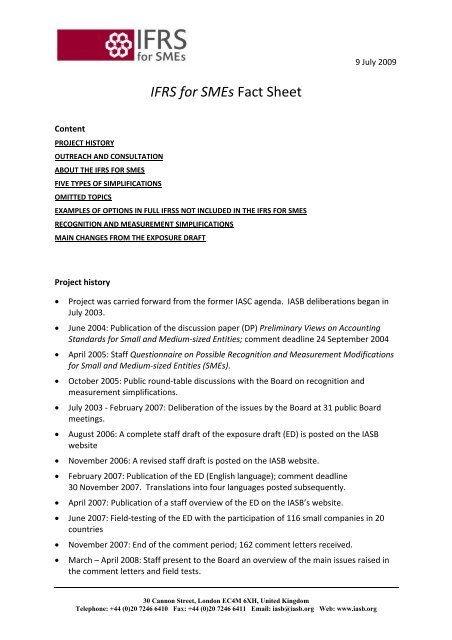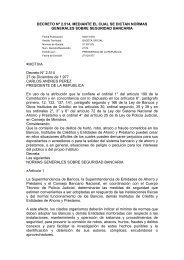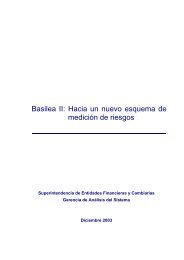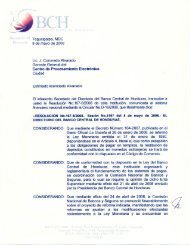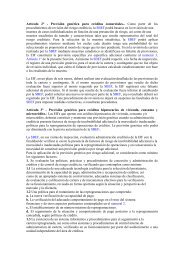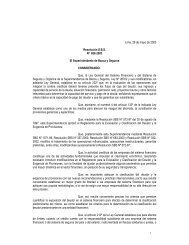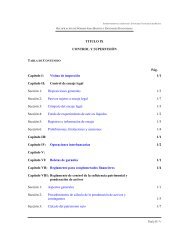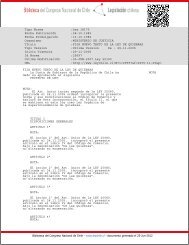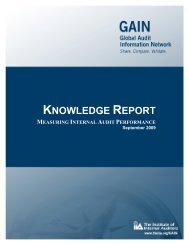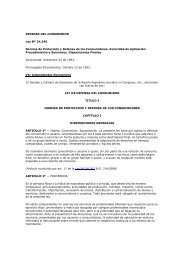IFRS for SMEs Fact Sheet
IFRS for SMEs Fact Sheet
IFRS for SMEs Fact Sheet
Create successful ePaper yourself
Turn your PDF publications into a flip-book with our unique Google optimized e-Paper software.
9 July 2009<br />
<strong>IFRS</strong> <strong>for</strong> <strong>SMEs</strong> <strong>Fact</strong> <strong>Sheet</strong><br />
Content<br />
PROJECT HISTORY<br />
OUTREACH AND CONSULTATION<br />
ABOUT THE <strong>IFRS</strong> FOR SMES<br />
FIVE TYPES OF SIMPLIFICATIONS<br />
OMITTED TOPICS<br />
EXAMPLES OF OPTIONS IN FULL <strong>IFRS</strong>S NOT INCLUDED IN THE <strong>IFRS</strong> FOR SMES<br />
RECOGNITION AND MEASUREMENT SIMPLIFICATIONS<br />
MAIN CHANGES FROM THE EXPOSURE DRAFT<br />
Project history<br />
Project was carried <strong>for</strong>ward from the <strong>for</strong>mer IASC agenda. IASB deliberations began in<br />
July 2003.<br />
June 2004: Publication of the discussion paper (DP) Preliminary Views on Accounting<br />
Standards <strong>for</strong> Small and Medium‐sized Entities; comment deadline 24 September 2004<br />
April 2005: Staff Questionnaire on Possible Recognition and Measurement Modifications<br />
<strong>for</strong> Small and Medium‐sized Entities (<strong>SMEs</strong>).<br />
October 2005: Public round‐table discussions with the Board on recognition and<br />
measurement simplifications.<br />
July 2003 ‐ February 2007: Deliberation of the issues by the Board at 31 public Board<br />
meetings.<br />
August 2006: A complete staff draft of the exposure draft (ED) is posted on the IASB<br />
website<br />
November 2006: A revised staff draft is posted on the IASB website.<br />
February 2007: Publication of the ED (English language); comment deadline<br />
30 November 2007. Translations into four languages posted subsequently.<br />
April 2007: Publication of a staff overview of the ED on the IASB’s website.<br />
June 2007: Field‐testing of the ED with the participation of 116 small companies in 20<br />
countries<br />
November 2007: End of the comment period; 162 comment letters received.<br />
March – April 2008: Staff present to the Board an overview of the main issues raised in<br />
the comment letters and field tests.<br />
30 Cannon Street, London EC4M 6XH, United Kingdom<br />
Telephone: +44 (0)20 7246 6410 Fax: +44 (0)20 7246 6411 Email: iasb@iasb.org Web: www.iasb.org
April 2008: Working Group submits comprehensive recommendations <strong>for</strong> possible<br />
changes to the ED.<br />
May 2008 ─ April 2009: Board redeliberations of the proposals in the ED at 13 public<br />
Board meetings.<br />
April 2009: Board decides that the name of the final standard will be International<br />
Financial Reporting Standard <strong>for</strong> Small and Medium‐sized Entities (<strong>IFRS</strong> <strong>for</strong> <strong>SMEs</strong>), as<br />
proposed in the ED.<br />
June 2009: 13 Board members vote in favour, 1 dissenting opinion.<br />
July 2009: Publication of the <strong>IFRS</strong> <strong>for</strong> <strong>SMEs</strong><br />
Outreach and consultation<br />
<br />
<br />
<br />
<br />
Project discussed with the Standards Advisory Council at seven SAC meetings.<br />
World Accounting Standard‐Setters: Project discussed at five annual meetings of the<br />
World Accounting Standard‐Setters hosted by the IASB (2003, 2005, 2006, 2007, 2008).<br />
Working Group meetings: The Working Group met four times to discuss the issues and<br />
provide advice to the Board (2003, 2005, 2006, 2008)<br />
Translations: The ED was translated into five languages to increase outreach:<br />
o Spanish April 2007<br />
o French May 2007<br />
o German June 2007<br />
o Polish September 2007<br />
o Romanian September 2007<br />
Field testing: A questionnaire on the ED was posted on the IASB’s website in June 2007<br />
in English, French and Spanish. Deadline <strong>for</strong> submitting field test reports 30 November<br />
2007. Field testers asked to restate their most recent financial statements using the ED<br />
and respond to a questionnaire. Responses received from 116 <strong>SMEs</strong> in 20 countries.<br />
<br />
<br />
<br />
IASB deliberations: The IASB discussed the project in a total of 44 public meetings.<br />
Presentations and conferences: With the objectives of encouraging <strong>SMEs</strong> and smaller<br />
auditing firms to become familiar with the IASB and the <strong>SMEs</strong> project, the staff<br />
undertook a comprehensive outreach programme that involved presentations at 104<br />
conferences and round tables in 40 countries, including 55 presentations after the ED<br />
was published.<br />
Webcasts: The IASB explained the ED and responded to questions in two public<br />
webcasts <strong>for</strong> which nearly 1,000 participants registered.<br />
About the <strong>IFRS</strong> <strong>for</strong> <strong>SMEs</strong><br />
Five types of simplifications<br />
The <strong>IFRS</strong> <strong>for</strong> <strong>SMEs</strong> contains five types of simplifications of full <strong>IFRS</strong>s:<br />
page 2
some topics in <strong>IFRS</strong>s are omitted because they are not relevant to typical <strong>SMEs</strong><br />
some accounting policy options in full <strong>IFRS</strong>s are not allowed because a more simplified<br />
method is available to <strong>SMEs</strong><br />
simplification of many of the recognition and measurement principles that are in full<br />
<strong>IFRS</strong>s<br />
substantially fewer disclosures<br />
simplified redrafting<br />
Omitted topics<br />
The <strong>IFRS</strong> <strong>for</strong> <strong>SMEs</strong> does not address the following topics that are covered in full <strong>IFRS</strong>s:<br />
earnings per share<br />
interim financial reporting<br />
segment reporting<br />
special accounting <strong>for</strong> assets held <strong>for</strong> sale<br />
Examples of options in full <strong>IFRS</strong>s NOT included in the <strong>IFRS</strong> <strong>for</strong> <strong>SMEs</strong><br />
<br />
<br />
<br />
<br />
<br />
financial instrument options, including available‐<strong>for</strong>‐sale, held‐to‐maturity and fair value<br />
options<br />
the revaluation model <strong>for</strong> property, plant and equipment, and <strong>for</strong> intangible assets<br />
proportionate consolidation <strong>for</strong> investments in jointly‐controlled entities<br />
<strong>for</strong> investment property, measurement is driven by circumstances rather than allowing<br />
an accounting policy choice between the cost and fair value models<br />
various options <strong>for</strong> government grants.<br />
Recognition and measurement simplifications<br />
The main simplifications to the recognition and measurement principles in full <strong>IFRS</strong>s include:<br />
<br />
<br />
Financial instruments:<br />
o Financial instruments meeting specified criteria are measured at cost or amortised<br />
cost. All others are measured at fair value through profit or loss. This avoids the<br />
inherent complexities of classifying financial instruments into four categories, such<br />
as assessing management’s intentions and dealing with ‘tainting provisions’.<br />
o The <strong>IFRS</strong> establishes a simple principle <strong>for</strong> derecognition. The ‘pass‐through’ and<br />
‘continuing involvement’ tests in full <strong>IFRS</strong>s are dropped.<br />
o Hedge accounting requirements, including the detailed calculations, are simplified<br />
and tailored <strong>for</strong> <strong>SMEs</strong>.<br />
Goodwill and other indefinite‐life intangible assets ― Always amortised over their<br />
estimated useful lives (ten years if useful life cannot be estimated reliably).<br />
page 3
Investments in associates and joint ventures ‐ can be measured at cost unless there is a<br />
published price quotation (when fair value must be used).<br />
Research and development costs ― must be recognised as expenses.<br />
Borrowing costs ―must be recognised as expenses.<br />
Property, plant and equipment and intangible assets ‐ Residual value, useful life and<br />
depreciation method <strong>for</strong> items of property, plant and equipment, and amortisation<br />
period/method <strong>for</strong> intangible assets, need to be reviewed only if there is an indication<br />
they may have changed since the most recent annual reporting date (full <strong>IFRS</strong>s require<br />
an annual review).<br />
Defined benefit plans:<br />
o All past service cost must be recognised immediately in profit or loss.<br />
o All actuarial gains and losses must be recognised immediately either in profit of loss<br />
or other comprehensive income.<br />
o An entity is required to use the projected unit credit method to measure its defined<br />
benefit obligation and the related expense only if it is possible to do so without<br />
undue cost or ef<strong>for</strong>t.<br />
Income tax ― Requirements follow the approach set out in the Board’s ED Income Tax,<br />
published in March 2009, which proposes a simplified replacement <strong>for</strong> IAS 12 Income<br />
Taxes.<br />
No separate held‐<strong>for</strong>‐sale classification ― Instead, holding an asset (or group of assets)<br />
<strong>for</strong> sale is an impairment indicator.<br />
Biological assets ― The fair value through profit or loss model is required <strong>for</strong> biological<br />
assets only when fair value is readily determinable without undue cost or ef<strong>for</strong>t.<br />
Otherwise, <strong>SMEs</strong> follow the cost‐depreciation‐impairment model.<br />
Equity‐settled share‐based payment ― The directors’ best estimate of the fair value of<br />
the equity‐settled share‐based payment is used to measure the expense if observable<br />
market prices are not available.<br />
Main changes from the ED<br />
The main changes that resulted from the Board’s redeliberations of the recognition,<br />
measurement and presentation principles proposed in the ED include:<br />
Making the <strong>IFRS</strong> a stand‐alone document (eliminating all but one of the 23<br />
cross‐references to full <strong>IFRS</strong>s that had been proposed in the ED, with the one remaining<br />
cross‐reference providing an option, but not a requirement, to follow IAS 39 Financial<br />
Instruments: Recognition and Measurement instead of the two financial instruments<br />
sections of the <strong>IFRS</strong> <strong>for</strong> <strong>SMEs</strong>).<br />
<br />
Eliminating most of the complex options and adding guidance on the remaining ones<br />
(thereby removing the cross‐references to full <strong>IFRS</strong>s proposed in the ED).<br />
page 4
Omitting topics that typical <strong>SMEs</strong> are not likely to encounter (thereby removing the<br />
cross‐references to full <strong>IFRS</strong>s proposed in the ED).<br />
Not anticipating possible future changes to <strong>IFRS</strong>s.<br />
Eliminating references to the pronouncements of other standard‐setting bodies as a<br />
source of guidance when the <strong>IFRS</strong> <strong>for</strong> <strong>SMEs</strong> does not address an accounting issue<br />
directly.<br />
Restructuring of the single section on financial instruments in the ED into two sections<br />
(Section 11 Basic Financial Instruments and Section 12 Other Financial Instruments<br />
Issues) and clarifying that amortised cost is applied to nearly all the basic financial<br />
instruments held or issued by <strong>SMEs</strong>.<br />
Eliminating proportionate consolidation as an option <strong>for</strong> investments in jointly<br />
controlled entities.<br />
Removing the distinction between distributions from pre‐acquisition and<br />
post‐acquisition profits <strong>for</strong> investments accounted <strong>for</strong> by the cost method and,<br />
instead, recognising all dividends received in profit or loss.<br />
<br />
<br />
<br />
<br />
<br />
<br />
<br />
<br />
<br />
<br />
<br />
Eliminating the requirement of a maximum three‐month difference between the<br />
reporting date of the associate or jointly controlled entity and that of the investor when<br />
applying the equity method.<br />
Requiring an entity to choose its accounting policy <strong>for</strong> investment property on the<br />
basis of circumstances, rather than as a free choice option. Investment property whose<br />
fair value can be measured reliably without undue cost or ef<strong>for</strong>t will be measured at fair<br />
value through profit or loss. All other investment property will be accounted <strong>for</strong> as<br />
property, plant and equipment using a cost‐depreciation‐impairment model.<br />
Not requiring an annual review of residual value, useful life and depreciation method of<br />
property, plant and equipment and intangible assets.<br />
Not permitting a revaluation option <strong>for</strong> property, plant and equipment.<br />
Not permitting a revaluation option <strong>for</strong> intangibles.<br />
Amortising all indefinite‐life intangibles, including goodwill.<br />
Recognising as expenses all research and development costs.<br />
Incorporating ‘present value of minimum lease payments’ into the measurement of a<br />
finance lease.<br />
Allowing other than the straight‐line method by lessees <strong>for</strong> operating leases when the<br />
minimum lease payments are structured to compensate the lessor <strong>for</strong> expected general<br />
inflation.<br />
Incorporating into the <strong>IFRS</strong> <strong>for</strong> <strong>SMEs</strong> the February 2008 ‘puttables’ amendments to<br />
IAS 32 Financial Instruments: Presentation and IAS 1 Presentation of Financial<br />
Statements.<br />
Requiring all government grants to be accounted <strong>for</strong> using a single, simplified model:<br />
recognition in income when the per<strong>for</strong>mance conditions are met (or earlier if there are<br />
no per<strong>for</strong>mance conditions) and measurement at the fair value of the asset received or<br />
receivable.<br />
page 5
Recognising as expenses all borrowing costs.<br />
Adding further simplifications <strong>for</strong> share‐based payments, including directors’<br />
valuations, rather than the intrinsic value method.<br />
Allowing subsidiaries to measure employee benefit and share‐based payment expense<br />
on the basis of a reasonable allocation of the group charge.<br />
Adding value‐in‐use measurement <strong>for</strong> asset impairments.<br />
Introducing the notion of cash‐generating unit <strong>for</strong> testing asset impairments.<br />
Simplifying the guidance <strong>for</strong> calculating impairment of goodwill.<br />
Simplifying the measurement of a defined benefit pension obligation if a ‘projected<br />
unit credit’ measurement is not available and would require undue cost or ef<strong>for</strong>t.<br />
Permitting recognition of actuarial gains and losses in other comprehensive income as<br />
an alternative to recognition in profit or loss (while retaining the proposal in the<br />
exposure draft to prohibit deferral of actuarial gains and losses).<br />
Eliminating the held‐<strong>for</strong>‐sale asset classification and related special measurement<br />
requirements.<br />
Incorporating into Section 35 Transition to the <strong>IFRS</strong> <strong>for</strong> <strong>SMEs</strong> all the exemptions in<br />
<strong>IFRS</strong> 1 First‐time Adoption of International Financial Reporting Standards.<br />
Incorporating the conclusions of the following Interpretations, which address<br />
transactions and circumstances that <strong>SMEs</strong> often encounter:<br />
o IFRIC 2 Members’ Shares in Co‐operative Entities and Similar Instruments<br />
o IFRIC 4 Determining whether an Arrangement contains a Lease<br />
o IFRIC 8 Scope of <strong>IFRS</strong> 2<br />
o IFRIC 12 Service Concession Arrangements<br />
o IFRIC 13 Customer Loyalty Programmes<br />
o IFRIC 15 Agreements <strong>for</strong> the Construction of Real Estate<br />
o IFRIC 17 Distributions of Non‐cash Assets to Owners<br />
o SIC‐12 Consolidation—Special Purpose Entities<br />
page 6


